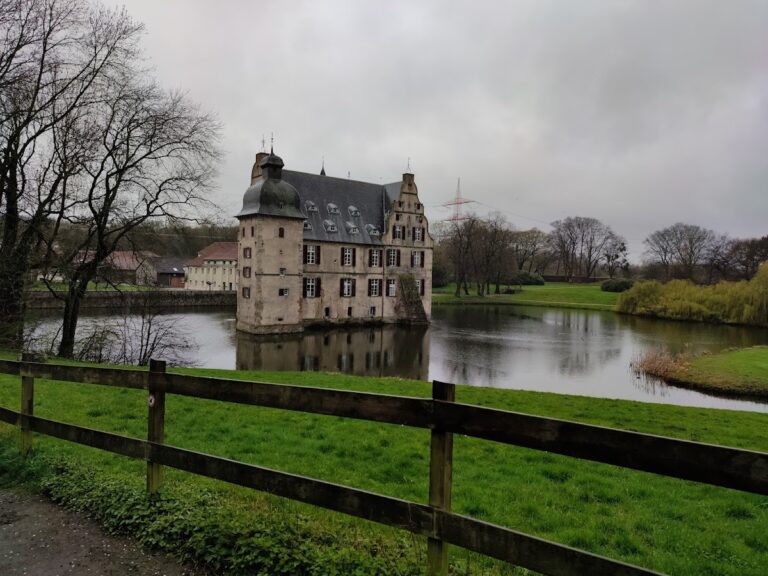Burg Lüdinghausen: A Medieval and Renaissance Water Castle in Germany
Visitor Information
Google Rating: 4.5
Popularity: Low
Google Maps: View on Google Maps
Official Website: www.burg-luedinghausen.de
Country: Germany
Civilization: Medieval European
Remains: Military
History
Burg Lüdinghausen is located in the municipality of Lüdinghausen in modern-day Germany. It was originally built by medieval German knights during the 12th century as a fortified residence and stronghold.
The castle first appears in historical records in 1271. At that time, it served as the seat of the knights of Lüdinghausen, who held the estate as ministeriales—servants of noble rank—under the Bishop of Münster. These knights were enfeoffed with the castle by the Abbey of Werden, highlighting the religious and feudal ties that shaped the region’s governance. During this period, the castle was involved in local power conflicts. In 1271, Bishop Gerhard von der Mark led a military campaign against the castle due to the Lüdinghausen lords’ efforts to assert independence and their construction of the nearby Burg Wolfsberg. After their defeat, Burg Lüdinghausen was permitted to remain standing but was declared an open house to the bishop, signalling a limitation on the knights’ autonomy.
Through the 14th and 15th centuries, Burg Lüdinghausen expanded to include several important structural components such as a gatehouse, two stone residential buildings each with kitchens, a bergfried (a tall central tower or keep), and a chapel connected to the gatehouse. The castle remained under the control of the Lüdinghausen family until their line ended in 1443. Following this, ownership passed directly to the Bishop of Münster.
By the end of the 15th century, Dietrich von Heyden acquired the property, and after his death in 1509, the castle entered the administration of the Münster cathedral chapter, serving as one of their seats. However, by 1538, records describe the castle as being in poor condition and in need of repair. Between 1569 and 1573, Domkapitular Gottfried von Raesfeld undertook a significant rebuilding of Burg Lüdinghausen in the Renaissance style, restoring the structure on its original foundations and updating its appearance to reflect contemporary taste.
The castle’s history also includes a somber chapter in 1624 when it functioned as a site for witch trials. At least twenty individuals were executed following interrogations conducted in the castle’s court building, reflecting the broader wave of witch persecutions in early modern Germany. During the Thirty Years’ War (1618–1648), Hessian troops occupied Burg Lüdinghausen for three years and made expansions to its fortifications.
In the 19th century, changes continued as the bergfried was dismantled in 1829, with the tower’s former position marked today in the courtyard pavement. The castle became privately owned starting in 1802 and was repurposed as an agricultural school from 1869 until 1972. Renovations throughout the late 19th and early 20th centuries included rebuilding the west wing and refurbishing the gatehouse and south wing facade. By the year 2000, the castle underwent restoration and was converted into a cultural and event center operated by the city.
Remains
Burg Lüdinghausen is a water castle (Wasserburg), characterized by its placement on a protected island encircled by moats and connected ring ditches that once formed an elaborate defensive system. The original fortifications comprised six to seven concentric rings of ditches surrounding the site, topped by a semicircular earthwork, all fed by water channels from the nearby Stever River and the mill channel associated with Burg Vischering. The moats also linked to the town defenses of Lüdinghausen, creating an integrated system of protection between the castle and the settlement.
The main castle’s current layout prominently features the south wing, constructed in 1573 during the Renaissance restoration, and a west wing dating from the late 19th century. The masonry of these buildings may incorporate parts of an older residential tower, suggesting continuity in occupancy and rebuilding over centuries. The location where the bergfried once stood—a round tower roughly 11 meters in diameter—is commemorated within the courtyard pavement, marking an important architectural element of the medieval castle now no longer visible above ground.
To the east of the main castle lies a moated outer bailey (vorburg) that contains a gatehouse and a building known as the Bauhaus. Only the north wall of this structure dates back to 1569; the remainder was reconstructed in the 19th century. This outer bailey served as an additional fortified enclosure before the main castle itself. Attached eastward to this is a second moated outer bailey, which remains surrounded by water but appears never to have been developed with permanent buildings.
Westward of the main castle, the moat forms a concentric ring around the central island, now visible as a shallow depression in the terrain that retains some water. This feature underlines the complex water defenses that once safeguarded the residence.
Architectural details from the castle’s Renaissance rebuilding include a carved stone list recording food prices from 1573/74, various coats of arms decorating the facade, and an inscription that commemorates a city fire in 1569, preserving evidence of local events linked to the castle’s history. These artistic and functional elements provide insight into the daily life and administrative duties conducted at Burg Lüdinghausen.
Inside the castle, the upper rooms combine traditional construction with modern adaptations and serve today as conference spaces. The castle’s large hall stands out for its rich decoration featuring numerous heraldic emblems, reflecting the noble affiliations and historical status of its occupants; this hall currently hosts concerts and cultural programs organized by the city.
Together, these remains demonstrate Burg Lüdinghausen’s evolution from a medieval stronghold to a Renaissance residence and later institutional facility, maintaining its historical footprint within the landscape of Lüdinghausen.










